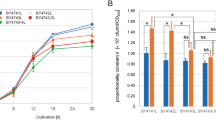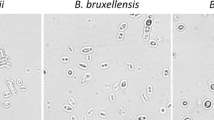Abstract
Live monitoring of microorganisms growth in liquid medium is a desired parameter for many research fields. A wildly used approach for determining microbial liquid growth quantification is based on light scattering as the result of the physical interaction of light with microbial cells. These measurements are generally achieved using costly table-top instruments; however, a live, reliable, and straight forward instrument constructed using parts that are inexpensive may provide opportunities for many researchers. Here, such an instrument has been constructed and tested. It consists of modular test tube holding chambers, each with a low power monochromatic light-emitting diode, and a monolithic photodiode. A microcontroller connects to all modular chambers to control the diodes, and send the live data to either an LCD screen, or a computer. This work demonstrate that this modular instrument can determine precise cell concentrations for the bacteria Escherichia coli and Pseudomonas syringae pv. tomato DC3000, as well as Saccharomyces cerevisiae yeast.





Similar content being viewed by others
References
Cantrell KM, Ingle JD (2003) The SLIM spectrometer. Anal Chem 75(1):27–35. doi:10.1021/ac026015s
Dasgupta PK, Eom I-Y, Morris KJ, Li J (2003) Light emitting diode-based detectors: absorbance, fluorescence and spectroelectrochemical measurements in a planar flow-through cell. Anal Chim Acta 500(1–2):337–364. doi:10.1016/S0003-2670(03)00575-0
Flaschka H, McKeithan C, Paschal D (1973) Design and construction of cells for long-path photometers. Microchem J 18(2):152–154. doi:10.1016/0026-265X(73)90097-0
Koch AL (1968) Theory of the angular dependence of light scattered by bacteria and similar-sized biological objects. J Theor Biol 18(1):133–156. doi:10.1016/0022-5193(68)90174-4
Koch AL (1970) Turbidity measurements of bacterial cultures in some available commercial instruments. Anal Biochem 38(1):252–259. doi:10.1016/0003-2697(70)90174-0
Lamb JJ, Eaton-Rye JJ, Hohmann-Marriott MF (2012) An LED-based fluorometer for chlorophyll quantification in the laboratory and in the field. Photosynth Res 114(1):59–68. doi:10.1007/s11120-012-9777-y
Lamb JJ, Eaton-Rye JJ, Hohmann-Marriott MF (2013) A cost-effective solution for the reliable determination of cell numbers of microorganisms in liquid culture. Curr microbiol 67(2):123–129
Lamb JJ, Forfang K, Hohmann-Marriott M (2015). A practical solution for 77 K fluorescence measurements based on LED excitation and CCD array detector. PLoS ONE, 10(7), e0132258
Liu H, Dasgupta PK (1996) Analytical chemistry in a drop. Solvent extraction in a microdrop. Anal Chem 68(11):1817–1821. doi:10.1021/ac960145h
Mie G (1908) Beiträge zur Optik trüber Medien, speziell kolloidaler Metallösungen. Ann Phys-Berlin 330(3):377–445. doi:10.1002/andp.19083300302
O’Toole M, Diamond D (2008). Absorbance based light emitting diode optical sensors and sensing devices. Sensors, 8(4). doi:10.3390/s8042453
Yang H, Wei X, Liang X, Su M, Lu X (2008) A SoC and LED based reconfigurable subminiature spectrometer for hand-held measurement applications. Measurement 41(1):44–54. doi:10.1016/j.measurement.2006.11.022
Acknowledgements
Jacob would like to acknowledge ENERSENSE, NTNU for their support of this research. Alexander would like to thank Prof. Dr. Ralph Hückelhoven and Dr. Stefanie Ranf for providing lab equipment and consumables. We further would like to acknowledge Florian Lücking for printing the first prototypes and for general 3D-printing support. Special thanks goes to Florian Fäth, CEO of the Fäth GmbH (Eschau-Hobbach, Germany) for financial support to purchase a 3D-printer, making this research possible.
Author information
Authors and Affiliations
Corresponding author
Ethics declarations
Conflict of interest
The authors declare that they have no conflict of interest.
Rights and permissions
About this article
Cite this article
Kutschera, A., Lamb, J.J. Cost-Effective Live Cell Density Determination of Liquid Cultured Microorganisms. Curr Microbiol 75, 231–236 (2018). https://doi.org/10.1007/s00284-017-1370-3
Received:
Accepted:
Published:
Issue Date:
DOI: https://doi.org/10.1007/s00284-017-1370-3




